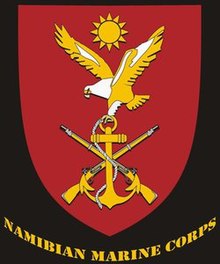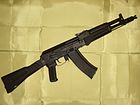
The Namibian Defence Force (NDF) comprises the national military forces of Namibia. It was created when the country, then known as South West Africa, gained independence from apartheid South Africa in 1990. Chapter 15 of the Constitution of Namibia establishes the NDF and defines its role and purpose as, " ... to defend the territory and national interests of Namibia".
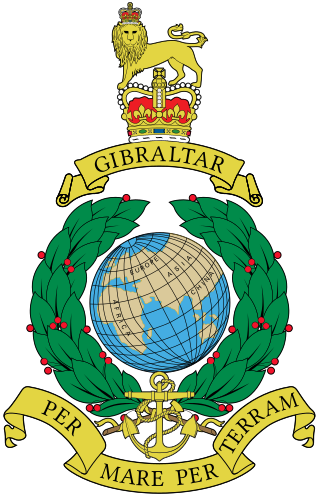
The Corps of His Majesty's Royal Marines (RM), today comprises the Royal Marines Commandos and the Royal Marines Band Service. They command and provide the majority of the United Kingdom's commando force, one of the five fighting arms of the Royal Navy and provide the Royal Navy's musicians. The Royal Marines trace their origins back to the formation of the "Duke of York and Albany's maritime regiment of Foot" on 28 October 1664, The first Royal Marines Commando unit was formed as part of the 3rd special service brigade at Deal in Kent on 14 February 1942 and designated 'The Royal Marine Commando'..
Ensign is a junior rank of a commissioned officer in the armed forces of some countries, normally in the infantry or navy. As the junior officer in an infantry regiment was traditionally the carrier of the ensign flag, the rank acquired the name. This rank has generally been replaced in army ranks by second lieutenant. Ensigns were generally the lowest-ranking commissioned officer, except where the rank of subaltern existed. In contrast, the Arab rank of ensign, لواء, liwa', derives from the command of units with an ensign, not the carrier of such a unit's ensign, and is today the equivalent of a major general.

Force Reconnaissance (FORECON) is a United States Marine Corps special operations forces which supplies military intelligence to the command element of the Marine Air-Ground Task Force (MAGTF). Force Reconnaissance companies unlike USMC division reconnaissance report to the Marine expeditionary force (MEF) and provide direct action and deep reconnaissance during large-scale operations.

The Marine Infantry is the naval infantry branch of the Spanish Navy responsible for conducting amphibious warfare. Fully integrated into the Spanish Navy's structure, the branch's history dates back to 1537 when Charles V, Holy Roman Emperor formed the Compañías Viejas del Mar de Nápoles, making it the oldest marine unit in existence.
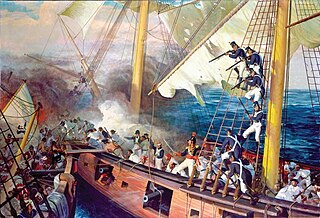
Marines, or naval infantry, are typically a military force trained to operate in littoral zones in support of naval operations. Historically, tasks undertaken by marines have included helping maintain discipline and order aboard the ship, the boarding of vessels during combat or capture of prize ships, and providing manpower for raiding ashore in support of the naval objectives. In most countries, the marines are an integral part of that state's navy.

The Marine Corps of the Republic of Indonesia , previously known as the Commando Corps of the Indonesian Navy, is an integral part of the Indonesian Navy and is sized at the military corps level unit as the naval infantry and main amphibious warfare force of Indonesia. The Marine Corps is commanded by a two-star Marine Major General.

The Brazilian Marine Corps, is the land combat branch of the Brazilian Navy. The Corps is specialised in amphibious warfare.

The United States Marine Corps is organized within the Department of the Navy, which is led by the Secretary of the Navy (SECNAV). The most senior Marine commissioned officer is the Commandant of the Marine Corps, responsible for organizing, recruiting, training, and equipping the Marine Corps so that it is ready for operation under the command of the unified combatant commanders. The Marine Corps is organized into four principal subdivisions: Headquarters Marine Corps, the Operating Forces, the Supporting Establishment, and the Marine Forces Reserve.

The Portuguese Marine Corps constitutes the Elite Marine Commandos and the Special Operations Branch of the Portuguese Navy. It has roles similar to the ones of the USMC Reconnaissance Battalions and of the Royal Marine Commandos and the 75th Ranger Regiment The Corps is specialised in air assault, amphibious warfare, anti-tank warfare, coastal reconnaissance and raiding, commando style raids, counterinsurgency, desert warfare, indirect fire support raiding, irregular warfare, ISTAR, jungle warfare, maneuver warfare, maritime interdiction, mountain warfare, providing security at naval base or shore stations, reconnaissance for gathering military intelligence, support special operations, tracking targets, urban warfare, and VBSS operations. It is an Elite Marine Commando Force, operating as a rapid-reaction force. Today's Corpo de Fuzileiros is the premier raid force. The Fuzileiros remains an all-volunteer force with an intensive screening and selection process followed by combat-focused training. Fuzileiros are resourced to maintain exceptional proficiency, experience and readiness.
The Naval Infantry Command, also known as the Naval Infantry of the Navy of the Argentine Republic and generally referred to in English as the Argentine marines are the amphibious warfare branch of the Argentine Navy and one of its four operational commands.
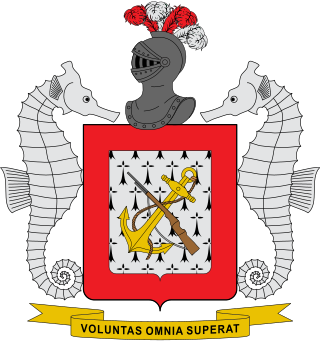
The Colombian Naval Infantry, also referred to as Colombian Marines, is the marine force of the Colombian National Armada. The 53,123-member Colombian Marine Infantry is organized into a single division with four brigades, each with several battalions plus numerous small security units.
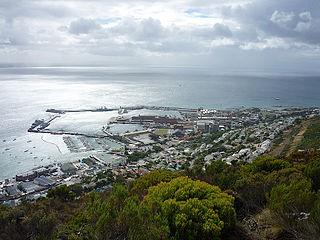
South Africa currently does not have a marine corps, though in the past it did. It was originally set up as a sub-branch of the South African Navy during the apartheid era, with the primary purpose of protecting the country's harbours (1951-1955). Then it was recreated in 1979 during the South African Border War as 1-Marine Brigade with the aim of serving as marine infantry (1979-1990). Today, the SAN Maritime Reaction Squadron is the closest analogue to a marine corps South Africa has.

The Pakistan Marines or simply as Pak Marines, is an expeditionary and amphibious warfare uniform service branch within the Pakistan Navy, consisting of the naval officers and other personnel to perform their duties within the Marines. Pakistan Marines are responsible for providing force protection in littorals, using the mobility of the Pakistan Navy to provide creeks defence, ground based air defence and Force protection.

The Naval Infantry Corps are the naval infantry force of the Mexican Navy. The main task of the Infantería de Marina is to guarantee the maritime security of the country's ports and external and internal defense of the country. To accomplish these responsibilities, the corps is trained and equipped to take on any type of operations from sea, air and land.

The Marine Corps Special Operations Battalion, also known as Tonelero Battalion or Amphibious Commandos (COMANF), is a special operations battalion of the Brazilian Marine Corps. Its attributes include planning, conducting and executing special reconnaissance, direct action, counterterrorism and hostage rescue operations in support of Brazilian Marine Corps operations.

The Namibian Navy is the maritime warfare branch of the Namibian Defence Force.

The Maritime Reaction Squadron (MRS) is a specialised marine-like unit of the South African Navy that provides a combat ready amphibious, diving and small boat capability to the Navy.
The Namibian Special Forces is a special operations command of the Namibian Defence Force responsible for special forces and special operations capable units. The command consists of Army commandos, Army Airborne paratroopers and the Marine Corps amphibious special operations unit. The Army commandos specialize in airborne and land borne insertion while the Marine Corps amphibious special operations unit specialize in small-unit maritime operations that originate from a river, ocean, swamp and delta. The army units receive training assistance from former South African Special Forces (Recces) and the marine corps from the Brazilian Marine Corps. The units regularly participate in Southern African Development Community (SADC) special forces exercises.
